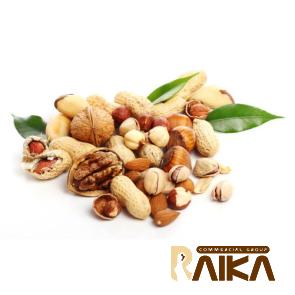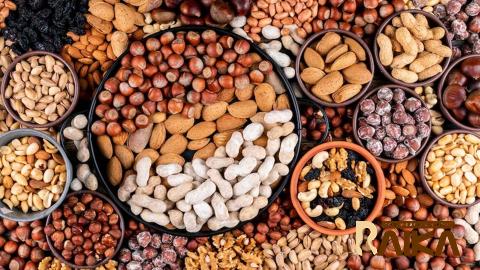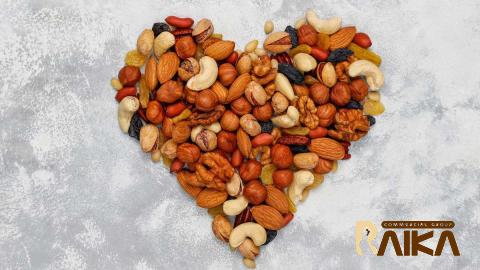The peanut, also known as the groundnut or goober, is a versatile and popular legume that is enjoyed all over the world. It is a staple ingredient in many cuisines, adding a nutty flavor and crunchy texture to a wide variety of dishes. One of the most fascinating aspects of peanuts is their rich history and cultural significance in different regions. In this article, we will explore the peanut’s role in Armenian cuisine and traditions, shedding light on its importance and unique characteristics. Armenia is a country located in the Caucasus region of Eurasia, known for its rich history, diverse culture, and flavorful cuisine. Armenian cuisine is a reflection of the country’s unique geography, climate, and cultural influences, resulting in a diverse array of dishes that are rich in flavor and tradition.

.
 Peanuts may not be native to Armenia, but they have found their way into Armenian cuisine and have become a beloved ingredient in many traditional dishes. One of the most popular uses of peanuts in Armenian cuisine is in a dish called “Մոլո հավույթ” (Molo Havuyt), which translates to “peanut soup” in English. This hearty and flavorful soup is made with a base of chicken broth, vegetables, herbs, and, of course, peanuts. The peanuts are crushed or ground into a paste and added to the soup to thicken it and add a rich, nutty flavor. The soup is then simmered until all the flavors are well combined, resulting in a savory and satisfying dish that is enjoyed by people of all ages. In addition to being used in savory dishes, peanuts are also a popular ingredient in Armenian desserts. One of the most famous peanut-based desserts in Armenian cuisine is “Ձևատ փաշ” (Jevar Pash), which is a sweet and sticky candy made with peanuts, sugar, and honey. The peanuts are roasted and then coated in a sugary syrup made from honey and sugar, resulting in a crunchy and satisfying treat that is enjoyed during holidays and special occasions. Peanuts are not only used in cooking in Armenia but also hold cultural significance in Armenian traditions and folklore. In Armenian culture, peanuts are often associated with good luck, prosperity, and abundance. It is common to find peanuts being used as a symbol of good fortune in various celebrations and rituals, such as weddings, New Year’s celebrations, and other festive occasions. The peanut plant itself is also highly valued in Armenian folklore, with many superstitions and stories surrounding the plant and its fruit. In some regions of Armenia, it is believed that planting a peanut plant near one’s home can bring protection and ward off evil spirits.
Peanuts may not be native to Armenia, but they have found their way into Armenian cuisine and have become a beloved ingredient in many traditional dishes. One of the most popular uses of peanuts in Armenian cuisine is in a dish called “Մոլո հավույթ” (Molo Havuyt), which translates to “peanut soup” in English. This hearty and flavorful soup is made with a base of chicken broth, vegetables, herbs, and, of course, peanuts. The peanuts are crushed or ground into a paste and added to the soup to thicken it and add a rich, nutty flavor. The soup is then simmered until all the flavors are well combined, resulting in a savory and satisfying dish that is enjoyed by people of all ages. In addition to being used in savory dishes, peanuts are also a popular ingredient in Armenian desserts. One of the most famous peanut-based desserts in Armenian cuisine is “Ձևատ փաշ” (Jevar Pash), which is a sweet and sticky candy made with peanuts, sugar, and honey. The peanuts are roasted and then coated in a sugary syrup made from honey and sugar, resulting in a crunchy and satisfying treat that is enjoyed during holidays and special occasions. Peanuts are not only used in cooking in Armenia but also hold cultural significance in Armenian traditions and folklore. In Armenian culture, peanuts are often associated with good luck, prosperity, and abundance. It is common to find peanuts being used as a symbol of good fortune in various celebrations and rituals, such as weddings, New Year’s celebrations, and other festive occasions. The peanut plant itself is also highly valued in Armenian folklore, with many superstitions and stories surrounding the plant and its fruit. In some regions of Armenia, it is believed that planting a peanut plant near one’s home can bring protection and ward off evil spirits.
..
 Additionally, peanuts are often used in traditional Armenian medicine for their purported health benefits, including their high nutrient content and antioxidant properties. From soups to desserts, from cultural traditions to folklore, peanuts have become an integral part of Armenian cuisine and culture. Their versatility, flavor, and nutritional value make them a valuable ingredient that is cherished by Armenians all over the world. Whether enjoyed in a savory soup or a sweet candy, peanuts continue to delight and inspire people with their rich history and unique characteristics. In conclusion, peanuts in Armenian cuisine are more than just a delicious ingredient – they are a symbol of tradition, culture, and prosperity. Their presence in Armenian dishes and customs highlights the adaptability and creativity of Armenian cuisine, which continues to evolve and thrive with each passing generation. So the next time you enjoy a bowl of Molo Havuyt or a piece of Jevar Pash, take a moment to appreciate the rich history and cultural significance of peanuts in Armenian cuisine. Peanuts have also woven their way into Armenian celebrations and festivities, adding a touch of flavor and symbolism to special occasions. In Armenian weddings, it is not uncommon to find peanuts being served as part of the traditional sweets table, symbolizing fertility, prosperity, and good fortune for the newlyweds. Guests may also receive small packets of peanuts as wedding favors, a token of well wishes and blessings for the couple’s future together. Furthermore, peanuts are a common feature in Armenian New Year’s celebrations, where they are often included in the traditional New Year’s spread called “ՁՈՐԱՅՈՑ ՀԱՎՈՒԶՓ” (Jorayatz Havuytz), which is a selection of symbolic foods eaten to bring luck and prosperity for the coming year. Peanuts are believed to represent abundance and growth, making them a fitting addition to this auspicious meal that is shared with family and loved ones.
Additionally, peanuts are often used in traditional Armenian medicine for their purported health benefits, including their high nutrient content and antioxidant properties. From soups to desserts, from cultural traditions to folklore, peanuts have become an integral part of Armenian cuisine and culture. Their versatility, flavor, and nutritional value make them a valuable ingredient that is cherished by Armenians all over the world. Whether enjoyed in a savory soup or a sweet candy, peanuts continue to delight and inspire people with their rich history and unique characteristics. In conclusion, peanuts in Armenian cuisine are more than just a delicious ingredient – they are a symbol of tradition, culture, and prosperity. Their presence in Armenian dishes and customs highlights the adaptability and creativity of Armenian cuisine, which continues to evolve and thrive with each passing generation. So the next time you enjoy a bowl of Molo Havuyt or a piece of Jevar Pash, take a moment to appreciate the rich history and cultural significance of peanuts in Armenian cuisine. Peanuts have also woven their way into Armenian celebrations and festivities, adding a touch of flavor and symbolism to special occasions. In Armenian weddings, it is not uncommon to find peanuts being served as part of the traditional sweets table, symbolizing fertility, prosperity, and good fortune for the newlyweds. Guests may also receive small packets of peanuts as wedding favors, a token of well wishes and blessings for the couple’s future together. Furthermore, peanuts are a common feature in Armenian New Year’s celebrations, where they are often included in the traditional New Year’s spread called “ՁՈՐԱՅՈՑ ՀԱՎՈՒԶՓ” (Jorayatz Havuytz), which is a selection of symbolic foods eaten to bring luck and prosperity for the coming year. Peanuts are believed to represent abundance and growth, making them a fitting addition to this auspicious meal that is shared with family and loved ones.
…
 Beyond their culinary and cultural significance, peanuts also play a role in the economy of Armenia. The cultivation and production of peanuts provide a source of income for many farmers in rural areas, contributing to the country’s agricultural sector and overall economic development. Armenians have embraced the peanut as both a nutritious food source and a valuable crop, showcasing the adaptability and innovation of Armenian farmers and food producers. In recent years, there has been a growing interest in incorporating peanuts and peanut products into modern Armenian cuisine, blending traditional recipes with innovative twists and flavors. Chefs and home cooks alike are experimenting with new ways to showcase the versatility of peanuts, from using peanut butter in savory sauces to incorporating roasted peanuts as a garnish for salads and desserts. This culinary evolution reflects the dynamic nature of Armenian cuisine, which continues to evolve and adapt to changing tastes and trends. In conclusion, peanuts in Armenian cuisine represent more than just a flavorful ingredient – they embody a rich tapestry of tradition, culture, and innovation. From ancient folklore to modern culinary trends, peanuts have carved out a special place in Armenian society, adding depth and meaning to everyday meals and special occasions. As Armenians around the world savor the taste of peanuts in their favorite dishes, they are also honoring a legacy of culinary excellence and cultural pride that has been passed down through generations. So the next time you bite into a piece of Jevar Pash or savor a spoonful of Molo Havuyt, remember the centuries of tradition and heritage that have shaped the role of peanuts in Armenian cuisine. Appreciate the ingenuity and creativity of Armenian cooks who continue to push the boundaries of flavor and tradition, creating a vibrant culinary landscape that celebrates the humble peanut in all its glory. Whether enjoyed in a soup, a sweet treat, or a festive snack, peanuts in Armenian cuisine will always hold a special place in the hearts and kitchens of Armenians everywhere.
Beyond their culinary and cultural significance, peanuts also play a role in the economy of Armenia. The cultivation and production of peanuts provide a source of income for many farmers in rural areas, contributing to the country’s agricultural sector and overall economic development. Armenians have embraced the peanut as both a nutritious food source and a valuable crop, showcasing the adaptability and innovation of Armenian farmers and food producers. In recent years, there has been a growing interest in incorporating peanuts and peanut products into modern Armenian cuisine, blending traditional recipes with innovative twists and flavors. Chefs and home cooks alike are experimenting with new ways to showcase the versatility of peanuts, from using peanut butter in savory sauces to incorporating roasted peanuts as a garnish for salads and desserts. This culinary evolution reflects the dynamic nature of Armenian cuisine, which continues to evolve and adapt to changing tastes and trends. In conclusion, peanuts in Armenian cuisine represent more than just a flavorful ingredient – they embody a rich tapestry of tradition, culture, and innovation. From ancient folklore to modern culinary trends, peanuts have carved out a special place in Armenian society, adding depth and meaning to everyday meals and special occasions. As Armenians around the world savor the taste of peanuts in their favorite dishes, they are also honoring a legacy of culinary excellence and cultural pride that has been passed down through generations. So the next time you bite into a piece of Jevar Pash or savor a spoonful of Molo Havuyt, remember the centuries of tradition and heritage that have shaped the role of peanuts in Armenian cuisine. Appreciate the ingenuity and creativity of Armenian cooks who continue to push the boundaries of flavor and tradition, creating a vibrant culinary landscape that celebrates the humble peanut in all its glory. Whether enjoyed in a soup, a sweet treat, or a festive snack, peanuts in Armenian cuisine will always hold a special place in the hearts and kitchens of Armenians everywhere.











Your comment submitted.